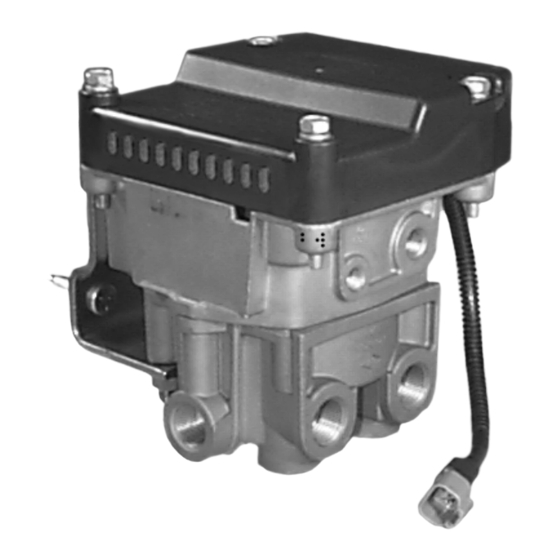BENDIX ATR-1 ANTILOCK TRACTION RELAY Технічний бюлетень
Переглянути онлайн або завантажити pdf Технічний бюлетень для Блок управління BENDIX ATR-1 ANTILOCK TRACTION RELAY. BENDIX ATR-1 ANTILOCK TRACTION RELAY 2 сторінки. Relay valves from de-icing chemicals
Також для BENDIX ATR-1 ANTILOCK TRACTION RELAY: Посібник (12 сторінок)

Technical
Bulletin No: TCH-013-017
Protect Your Bendix
Subject:
De-icing Chemicals
Vehicles exposed to harsh winters, de-icing and/or
other chemical sprays, often experience excessive
corrosion and contamination.
vehicles typically need maintenance more often,
and vehicle parts exposed to de-icing chemicals
tend to require replacement sooner. For air system
components, one potential result of exposure to
corrosion and contamination can be restricted or
blocked exhaust ports which can reduce air system
performance.
Regular maintenance routines typically include in-
spections for corrosion and contamination. Air control
valves with smaller secondary exhaust ports, such as
the Bendix
®
ATR-1
™
or ATR-2
®
and R-14
relay valves (See Figure 1), are especially
important to check. These valves are often situated
in diffi cult-to-reach locations on the vehicle, however,
by following the steps outlined in this Bulletin, the
technician can verify that the valves are functioning
correctly.
Bendix recommends that potentially affected
vehicles:
•
Use the specifi c test(s) below to determine if the
valves are functioning properly
•
Install air system components in areas protected
from direct splash and road spray, and install splash
guards where necessary
•
Have more frequent inspection and maintenance
schedules in regions that have greater exposure
to de-icing chemicals
Early indications that maintenance is required include
reports of "brake drag" — that service brakes appear
to be slow to release following a braking or traction
control event.
When conducting the following Tests, follow all industry
standard safety guidelines, including, but not limited to,
those shown on page two of this Bulletin.
In all cases, consult your vehicle manufacturer's
service manual for details of any further tests that they
recommend.
To Test ATR-1
™
and ATR-2
Valves:
The antilock traction control (ATC) system is tested
by connecting the vehicle to a PC with the Bendix
Effective Date: 7/30/08
®
™
ATR-1
, ATR-2
As a result, these
™
traction control valves
™
Traction Relay
Bulletin
Cancels: N/A
™
and R-14
Secondary Exhaust Ports (With Cover) are
Located Behind the Mounting Bracket
Relay Valve Exhaust Port
FIGURE 1 - EXAMPLES OF R-14
ATR-1
™
AND ATR-2
™
™
ACom
diagnostics program loaded. (ACom
software is available as a free download from www.
bendix.com). Run the ATC Valve Test provided in
ACom
™
diagnostics, and verify that the brakes are fully
releasing after the ATC event. If the brakes are slow
to release, replace the traction relay valve and repeat
the above check.
®
To Test R-14
Relay Valves:
Visually inspect (where possible) that the balance
exhaust port cover is present on the relay valve; in
cases where the cover is missing, replace the entire
valve with a new valve. During installation, confi rm
that the exhaust cover is fi rmly attached.
If the cover is present, verify that the R-14
used is functioning properly by fully charging the air
system and block and hold vehicle by means other than
the air brakes. Then make several brake applications
and check for prompt application and release of each
wheel's brakes with no perceptible lag.
If the brakes are slow to release, replace the relay valve
and repeat the above test. If the brakes continue to
®
exhibit slow release, refer to the troubleshooting section
in your vehicle manufacturer's service manual.
Page: 1 of 2
®
Relay Valves from
R-14
®
Relay Valve
Cover for Balance/
Quick Exhaust Port
(Used for Anti-
Compound Functions)
Relay Valve Exhaust Port
®
RELAY VALVE AND
TRACTION RELAY VALVES
®
relay valve
™
